This morning, the New York Times published an op-ed attributed to Sirajuddin Haqqani. Although Haqqani is described as the “deputy leader of the Taliban,” he is actually the deputy emir of the Taliban’s Islamic Emirate of Afghanistan. The importance of that observation will become apparent below.
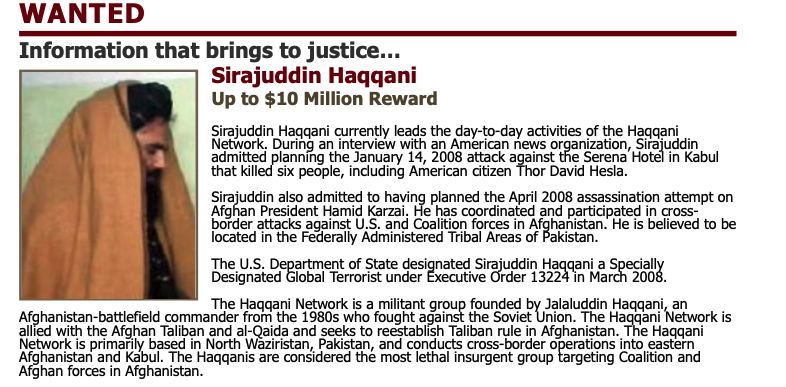
The author of the op-ed blames America for the war in Afghanistan, writing: “We did not choose our war with the foreign coalition led by the United States.” This ignores the Taliban’s role in harboring and assisting al-Qaeda in the years leading up to the 9/11 hijackings and thereafter. In fact, al-Qaeda is not named in the op-ed at all. It’s a telling omission: Sirajuddin’s own father helped cement the close relationship between the Taliban and Osama bin Laden’s outfit. A large body of evidence shows that Sirajuddin has continued in his father’s footsteps.
Who is Sirajuddin Haqqani? The Times doesn’t explain. Some basic facts are in order.
Sirajuddin Haqqani has been designated as a terrorist by both the U.S. and the United Nations. He leads a designated terrorist organization, the Haqqani Network, which is an integral part of the Taliban. Other Haqqani Network leaders have been designated as terrorists as well.
Both Sirajuddin and his organization were designated in part because of the Haqqanis’ long-standing partnership with al-Qaeda. The U.S. government and U.N. have repeatedly recognized this partnership in official statements. For instance, the State Department’s Country Reports on Terrorism explains that the Haqqani Network “is integrated into—and cooperates closely with—the larger Afghan Taliban and draws strength through cooperation with other terrorist organizations operating in Afghanistan, including al-Qaeda and Jaish-e Mohammad.”
Similarly, the State Department’s Rewards for Justice page for Sirajuddin notes: “The Haqqani Network is allied with the Afghan Taliban and al-Qaida and seeks to reestablish Taliban rule in Afghanistan.”
The U.S. has a standing reward offer of up to $10 million for information on Sirajuddin’s whereabouts. He is wanted for a string of high-profile terrorist attacks inside Afghanistan. Indeed, the Haqqani Network has been the most potent terrorist organization in the country.
The Haqqanis’ media shop touted the Islamic Emirate of Afghanistan’s return to power in a video released just this month.
Much of the op-ed attributed to Sirajuddin is intended to assuage legitimate concerns over the Taliban’s intentions for the future of Afghanistan. The author reassures readers that the future government of Afghanistan will be “depend on a consensus among Afghans.” There are benign-sounding phrases peppered throughout the piece.
However, the Haqqani Network has repeatedly stressed that it is waging jihad in order to return the Taliban’s authoritarian Islamic Emirate to power. The op-ed is at odds with the Haqqanis’ own stated position.
Earlier this month, for instance, the Haqqanis’ Manba’ Al-Jihad Media released a video touting the Islamic Emirate of Afghanistan’s successes. The video laments the final end of the Islamic Caliphate in the 1920s, arguing that since that time “the Muslims have been victims of division,” and “distance[d] from the Islamic Sharia [law].” In other words, Muslims haven’t been able to live under the type of strict religious laws favored by the Taliban—and al-Qaeda. But Muslims should view the Taliban’s “Islamic Emirate of Afghanistan” as the “most successful … Islamic movement,” a sign that they may “rise again” in communal power. The Haqqani production shop called on other “Islamic movements of the world” to follow the Islamic Emirate’s “jihadist, political, and military policies,” because in so doing they can avoid divisions, “gain popular support” and direct their efforts to “final victory.”
The Haqqanis’ media shop bragged that the Islamic Emirate of Afghanistan is becoming “stronger day after day,” as its “authority and influence is increasing.” Tellingly, the video also celebrated the “powerful attacks” carried out by the “Martyrdom-seeking” brothers against the “Crusader invaders.” That is, the video lauded the Taliban’s suicide bombers.
The video is not unusual. The Taliban regularly produces similar messages. Note that the author of the op-ed does not recognize the current Afghan government’s legitimacy, call for its reformation, or say that the Taliban intends to join it.
Jalaluddin Haqqani, Sirajuddin’s father, was one of Osama bin Laden’s most important mentors and allies. Al-Qaeda’s leaders eulogized Jalaluddin when his death was announced in 2018, describing Sirajuddin as one of their “emirs.”
Jalaluddin Haqqani, Sirajuddin’s father, founded the eponymous Haqqani Network. He was one of Osama bin Laden’s earliest backers. The close relationship between Jalaluddin and bin Laden has been documented in numerous sources. In the 1980s, Jalaluddin gave bin Laden a foothold in eastern Afghanistan, allowing him and others to establish al-Qaeda’s first training camps. Some of al-Qaeda’s earliest leaders were first trained by the Haqqanis.
The Taliban announced Jalaluddin’s death in September 2018. Al-Qaeda quickly issued a glowing eulogy. In a two-page statement, al-Qaeda’s leaders specifically addressed “our emirs in the Islamic Emirate,” meaning the Taliban’s top leader, Haibatullah Akhundzada, and his deputy, Sirajuddin Haqqani. Al-Qaeda’s senior leaders praised Sirajuddin in the same eulogy, saying they take “solace in the fact” that Sirajuddin is the “deputy of the Islamic Emirate of Afghanistan’s Emir of the Faithful” and is following in his father’s “footsteps.” Al-Qaeda asked Allah to protect and guide Sirajuddin.
Sirajuddin Haqqani appeared in a video celebrating the Taliban’s unity with al-Qaeda.
The author of the op-ed attempts to blame unnamed warmongers for legitimate concerns over the presence of international terrorists inside Afghanistan, including al-Qaeda. He writes: “Reports about foreign groups in Afghanistan are politically motivated exaggerations by the warmongering players on all sides of the war.”
But Sirajuddin Haqqani’s own career highlights why such concerns are entirely warranted.
In December 2016, the Haqqanis’ Manba’ Al-Jihad Media released a video celebrating the unbroken bond between the Taliban and al-Qaeda. Much of the production emphasized the close relationship between the two. For instance, a top al-Qaeda ideologue named Khalid Batarfi praised Mullah Omar for refusing to hand over Osama bin Laden in 2001. Batarfi lauded Omar for his willingness to sacrifice the Islamic Emirate in defense of bin Laden. However, all these years later, Batarfi said, the jihadists can finally “see [the] light of victory,” as governance according to the “rule of Sharia” law is “even stronger in Afghanistan than before.” That is, al-Qaeda is forecasting the Islamic Emirate’s return to power.
An archival audio clip of Sirajuddin was included in that same video. In it, Sirajuddin praised the founding of the Taliban’s Islamic Emirate of Afghanistan, saying it was not established for “fame,” or because people wanted to increase their “position,” but to implement Allah’s Sharia (Islamic law) “upon this land.” Sirajuddin held up the Islamic Emirate as an example for “Muslims both inside and outside” of Afghanistan to emulate. Again, this is inconsistent with the message conveyed in the op-ed published today by the New York Times.
Osama bin Laden’s files document cooperation between al-Qaeda and the Haqqanis.
Files recovered in Osama bin Laden’s compound in Abbottabad, Pakistan, document the close working relationship between al-Qaeda and the Haqqani Network.
For example, the files describe al-Qaeda’s cooperation with Sirajuddin in “special operations” and explain how al-Qaeda worked with Sirajuddin to pressure the Pakistani government into truce negotiations.
The U.N. Security Council continues to report on the partnership between al-Qaeda and the Haqqanis.
Since July 2018, the U.N. Security Council has published several reports by monitoring teams responsible for assessing the status of al-Qaeda and other terrorist groups. These reports document the ongoing and close relationship between the Taliban and al-Qaeda. Some of these same assessments also highlight the key role played by the Haqqanis.
For instance, a U.N. monitoring team explained last year that al-Qaeda “continues to cooperate closely with” the Haqqani Network. In another report, the U.N.’s analysts reported that the Haqqanis are overseeing much of the Taliban’s so-called “shadow” government – that is, the parallel infrastructure of the Islamic Emirate of Afghanistan, which seeks to overthrow and then replace the current government.
The op-ed attributed to Sirajuddin Haqqani will undoubtedly be cited by some as evidence that the Taliban is truly willing to pursue peace.
The facts tell a different story.
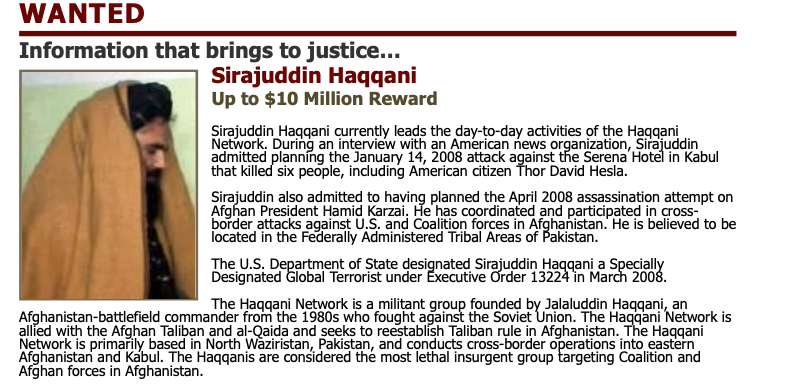
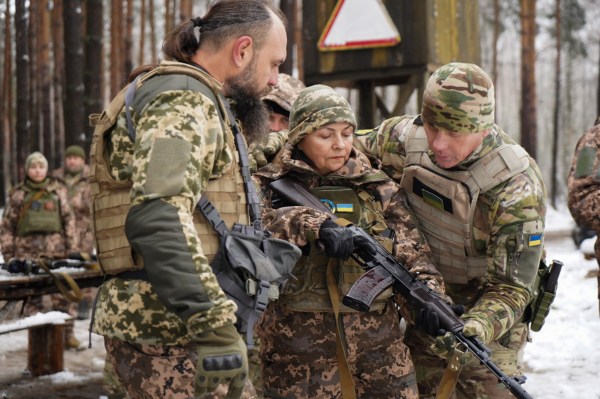
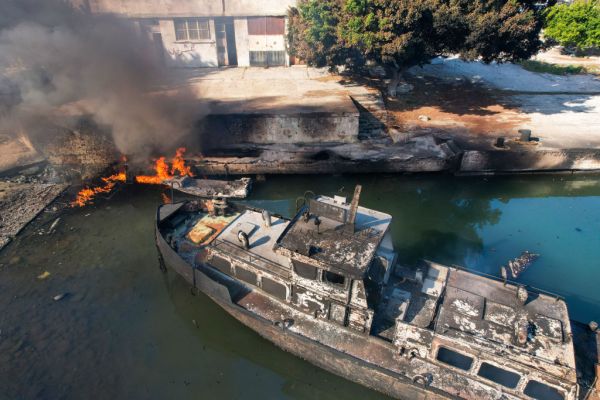



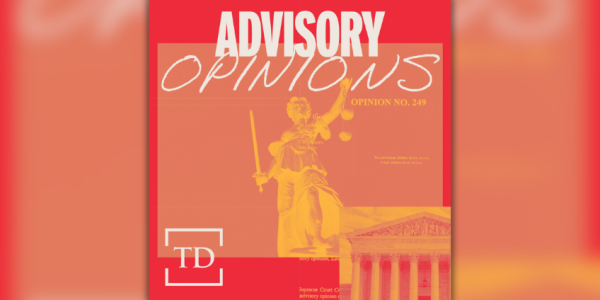
Please note that we at The Dispatch hold ourselves, our work, and our commenters to a higher standard than other places on the internet. We welcome comments that foster genuine debate or discussion—including comments critical of us or our work—but responses that include ad hominem attacks on fellow Dispatch members or are intended to stoke fear and anger may be moderated.
You are currently using a limited time guest pass and do not have access to commenting. Consider subscribing to join the conversation.
With your membership, you only have the ability to comment on The Morning Dispatch articles. Consider upgrading to join the conversation everywhere.